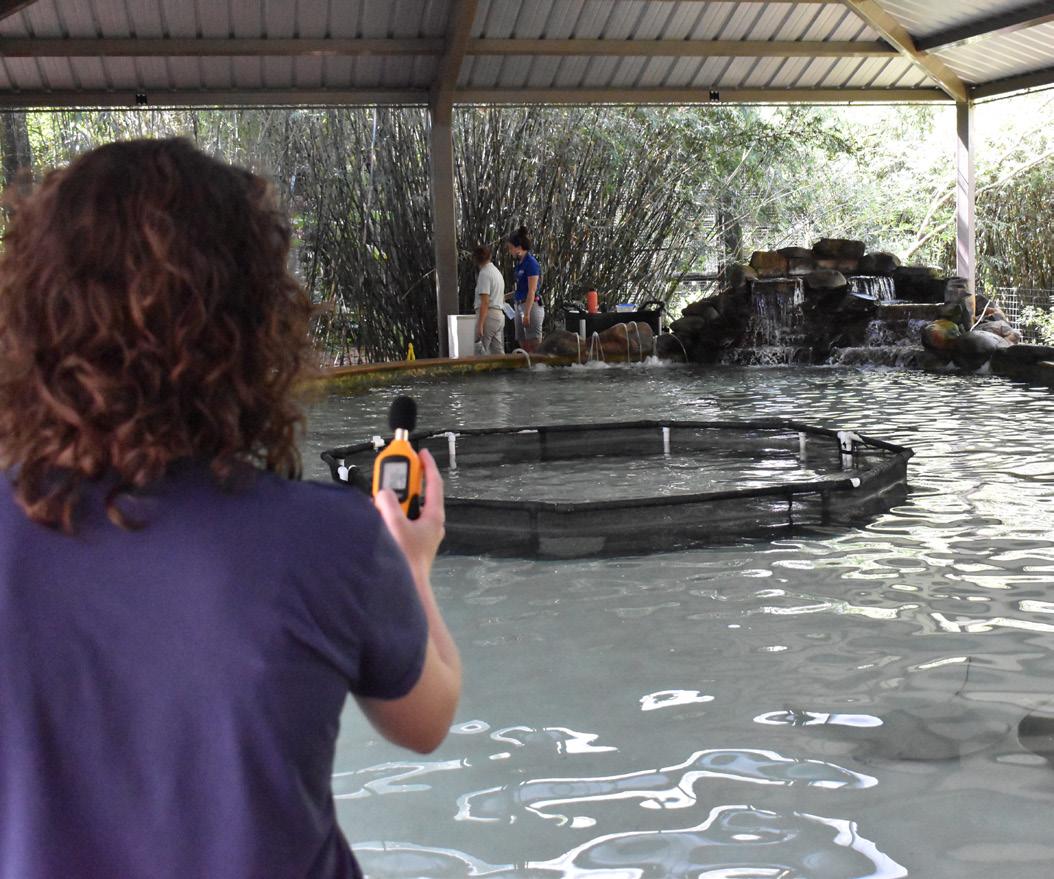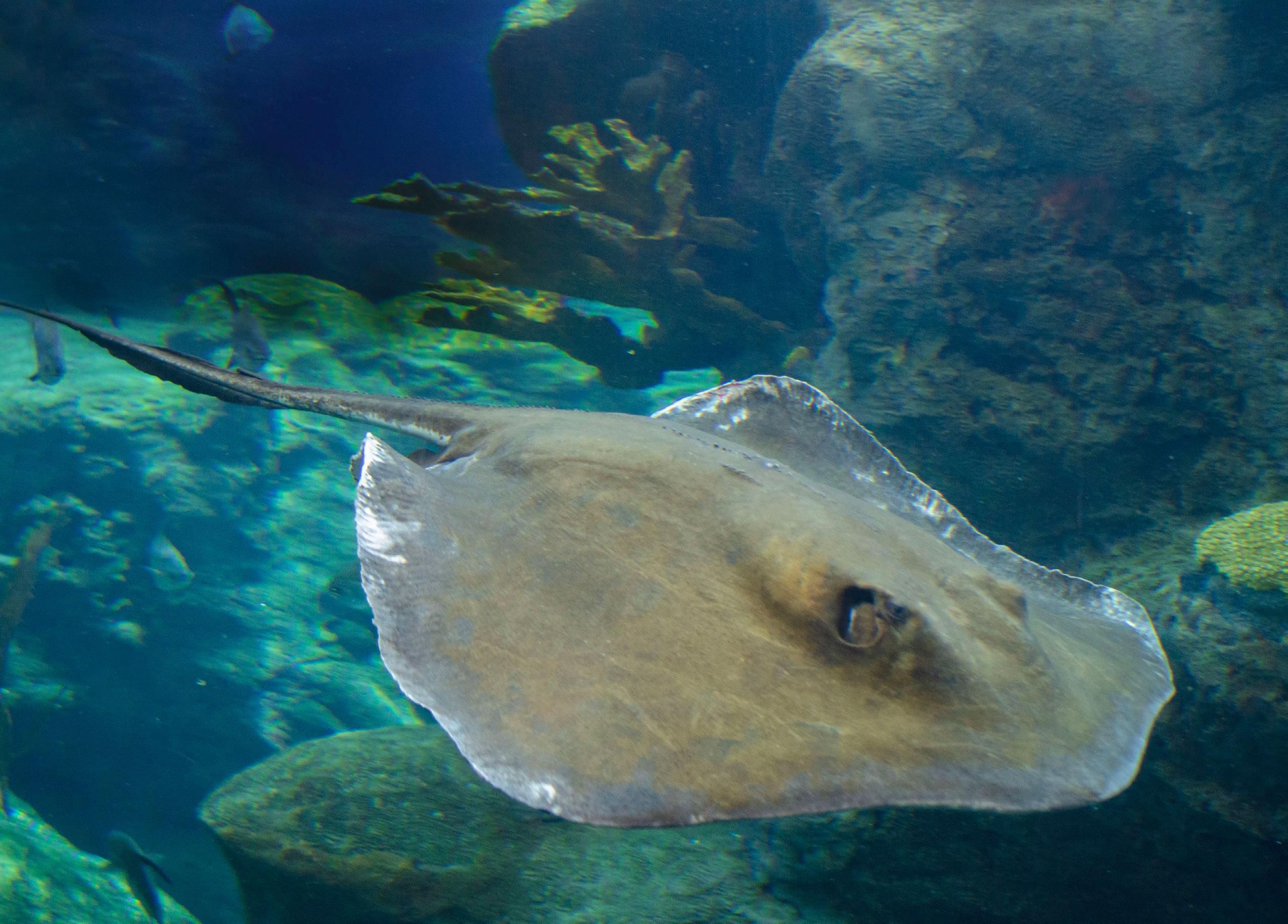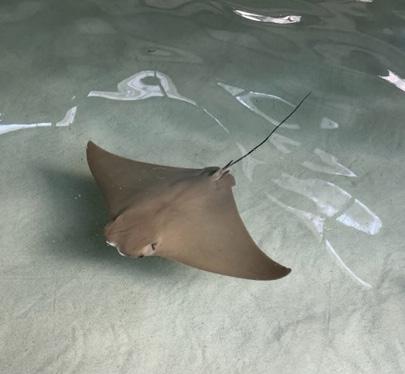
3 minute read
ANIMAL HEALTH Stingray Wellness
By Aimee Little, Applied Animal Wellness and Research Officer
If you have visited Stingray Bay in the last few months, you may have noticed changes to the area. But did you know these changes were inspired by novel animal behavior research conducted by both Zoo staff and graduate students from the University of North Florida (UNF)?
Advertisement
Aquatic touch pools are one of the most popular habitat designs in zoos and aquariums all over North America. They were first designed to help educate people about marine invertebrates like sea stars, but institutions quickly recognized the potential of these habitats by bringing “fingers to fins.” Tactile experiences like touch pools are considered powerful educational tools that can foster conservation engagement. Sharks and rays are important keystone predators in aquatic ecosystems, but many species are threatened or endangered due to anthropogenic factors like overfishing and pollution. Sharks, in particular, faced severe population declines in the 1970s and 1980s due in no small part to the public fear of sharks sparked by Steven Spielberg’s blockbuster, Jaws, based on the best-selling book by Peter Benchley, the late author-turned-ocean conservationist. In response, touch pools are utilized to provide more education about sharks and rays by replacing fear with fascination and respect through a fun, interactive experience.

However, even though touch pools are common in zoos and aquariums throughout the country, scientists are still learning more about shark and ray behavior to ensure that nearly 500 different species can thrive both in the wild and in human care. At the Zoo, the animal wellness and research teams conduct research to ensure that all animals living in our care from great apes to invertebrates have opportunities to thrive and experience positive wellbeing.
Achieving positive animal wellbeing starts with a good understanding of each species' unique needs and preferences. Research is an important tool that increases our knowledge of animals and what makes them thrive. In the case of the rays living at Stingray Bay, animal care staff wanted to better understand their behaviors, including how they interacted with each other and with the people who come to visit them. Are the rays getting along with each other? Which individuals like to spend time with each other the most? How much do the rays like interacting with people, and do some individuals like interacting with people more than others?
These were the questions the wellness and research team set out to answer. Through a unique partnership between the Zoo and UNF, our team can host a graduate student fellow from either the Psychology or Biology Departments to conduct their thesis research at the Zoo. Student research on the rays first began with my own thesis research in Fall 2020 to better understand how rays interacted with people, and how those interactions may be influencing the rays' interactions with each other.
The data showed that the cownose rays at Stingray Bay seek out interactions with people more compared to the other species (Atlantic Guitarfish, Atlantic Stingray, Bluntnose Stingray), and their behavior suggests they prefer interactions with people when they use a calm and gentle touch. Do you ever get that feeling of needing some alone time after hanging out with friends or going to a big party? Well, the data suggested that even the rays sometimes need alone time, too especially on busy days when a lot of people visit them. So, with this knowledge in hand, the animal care and education teams worked together to make modifications to Stingray Bay. When you visit Stingray Bay, you will hear interpretative guides providing instruction on using two fingers as a form of calm and gentle touch. You will also notice that the rays now have an area where they can choose to spend time and take a break from interacting with people if desired. Now, another UNF student, Kendal Rogers, is investigating the social relationships among individual cownose rays and if their place in the social hierarchy of the touch pool influences how much they seek out interaction with people and other features of their habitat (such as enrichment). This new study provides an opportunity to not only conduct novel social network research, which has never been done in a human-managed population in an AZA-accredited facility, but it also enables staff to observe how the changes made at Stingray Bay impact ray behavior. With this new research concluding in June 2023, we are excited to learn the everyday social dynamics within Stingray Bay and how it contributes toward positive animal wellbeing for the rays. Not only does this information benefit the Zoo, but it has the potential to help zoos and aquariums across the country provide the best care possible for sharks and rays living in aquatic touch pools.

Receive special benefits by supporting the Zoo's mission of conservation and education.

Jacksonville Zoological Society cordially invites you to the 2023 Annual Meeting

October 18, 5 – 6 p.m.
Samburu Room
Jacksonville Zoo and Gardens
All members are invited to attend the annual Board of Directors meeting where you can hear our President & CEO, Dr. Jeff Ettling recap the year and provide updates on the Zoo’s future.
RSVP by October 3 hausera@jacksonvillezoo.org
Include your name and number of guests attending.










